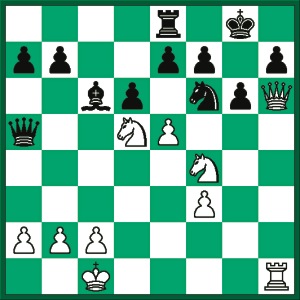|
Time
Out
The Dragon is alive Chess
The term
'fianchetto', which means flank development, may sound a bit
weird if you are not familiar with it. A bishop is fianchettoed
to bring its long-range firepower into play from a safe abode
surrounded by pawns. It can be very effective when the bishop
keeps a watchful eye on the long diagonal.
Of the
many variations of the Sicilian Defence, the Dragon, where
Black fianchettoes his black bishop , is perhaps the most
aggressive. Black plays for the full point, instead of fighting
for equality. But the plan has its pitfalls; White may unleash
a direct, powerful attack against the enemy king by advancing
his rook pawn and exchanging the Dragon bishop through a well
known manoeuvring. Once that is done, Black's job of defending
against the kingside attack can be very difficult.
It is
Bobby Fischer who tamed the Dragon by scoring some effortless
wins against it in the sixties. "White's attack plays
itself ", said Fischer with his typical optimism. Since
he was the best player in the world at that time, people trusted
him blindly and the Dragon had to go through a lean period.
Matters were made worse for it when Victor Korchnoi employed
it in the Candidates final against Karpov in 1974, only to
suffer a quick defeat. It seemed Fischer's observation received
a further boost.
But experts
think that Korchnoi's decision to play the Dragon was not
bad in itself. What he lacked was adequate preparation for
playing the razor-sharp opening.
Interestingly,
grandmasters around the world refused to believe that the
"slain Dragon' could not be revived. English Grandmaster
Tony Miles injected life into the much-maligned variation
by playing it regularly. He scored some convincing wins, and
soon others joined him in the mission to resurrect the Dragon.
Hungarian Grandmaster Gyula Sax and Miles' compatriot Jonathon
Mestel became the leading Dragon players in the late seventies.
Today the opening is fully rehabilitated and it attracts the
players who love to play highly complicated positions with
chances for both sides.
Look
how Karpov played against the Dragon in the match against
Korchnoi.
White-Anatoly
Karpov (2700)
Black-Viktor Kortschnoj (2670) [B78]
Candidates final Moscow, 1974
1.e4
c5 2.Nf3 d6 3.d4 cxd4 4.Nxd4 Nf6 5.Nc3 g6 6.Be3 Bg7 7.f3 Nc6
8.Qd2 00 9.Bc4 Bd7 10.h4 Rc8 11.Bb3 Ne5 12.000 Nc4 13.Bxc4
Rxc4 14.h5 Nxh5 15.g4 Nf6 16.Nde2 Qa5 17.Bh6 Bxh6 18.Qxh6
Rfc8 19.Rd3 R4c5 20.g5 Rxg5 21.Rd5 Rxd5 22.Nxd5 Re8 23.Nef4
Bc6 24.e5!+- Bxd5 25.exf6 exf6 26.Qxh7+ Kf8 27.Qh8+ 10

Position after 24.e5!
-PATZER
Copyright
(R) thedailystar.net 2004
| 